Blogs

Understanding Rolling Types: A Complete Tutorial on College Admissions Plans
Overview
The article focuses on explaining rolling admissions as a flexible college admissions strategy that allows applicants to submit applications at any time within a designated period, leading to quicker responses and potentially higher acceptance rates. It emphasizes that this approach benefits students by providing adaptability and reducing stress compared to traditional deadlines, while also highlighting the importance of early applications and strong academic performance in a competitive landscape.
Introduction
In the ever-evolving landscape of college admissions, rolling admissions have emerged as a pivotal strategy that offers students unique advantages and challenges. This approach allows prospective applicants to submit their applications at any point within a designated timeframe, facilitating a continuous evaluation process by institutions.
As students navigate this dynamic environment, understanding the nuances of rolling admissions is essential for maximizing their chances of acceptance. With competitive programs filling quickly and the flexibility to apply early, applicants must be proactive and well-prepared to seize opportunities.
This article delves into the intricacies of rolling admissions, including:
- Comparing it to other strategies
- Highlighting its benefits
- Addressing potential challenges
- Providing actionable tips for success
All aimed at empowering students to make informed decisions in their college journey.
Exploring Rolling Admissions: An Overview of College Admissions Plans
Rolling enrollment signifies a tactical method in the college enrollment environment, allowing individuals to submit requests at any moment within a designated period. This method enables institutions to assess submissions of rolling types as they come in and make decisions on an ongoing basis. The adaptability provided by continuous enrollment is especially advantageous for learners, allowing them to submit their requests earlier and obtain responses more quickly than those following conventional submission deadlines.
It is crucial for applicants to understand that applying early can significantly enhance their chances of acceptance, especially considering that programs at competitive institutions, such as Stanford which admitted only 4.69% of applicants for the Class of 2020, tend to fill quickly. Moreover, the continuous assessment procedure related to flexible entry requires that applicants prepare and submit through applications at the earliest chance. As Nat, an IvyWise college enrollment advisor, aptly puts it,
I think every college is still looking for their own way to try to diversify the class.
This illustrates the changing approaches in higher education enrollment, with many institutions progressively embracing flexible entry processes as part of their efforts to foster a more varied group of rolling types of learners. Furthermore, the significance of academic performance cannot be overstated; transcripts are frequently among the initial elements assessed by evaluators, and an individual’s GPA plays a crucial role in the selection decision-making process.
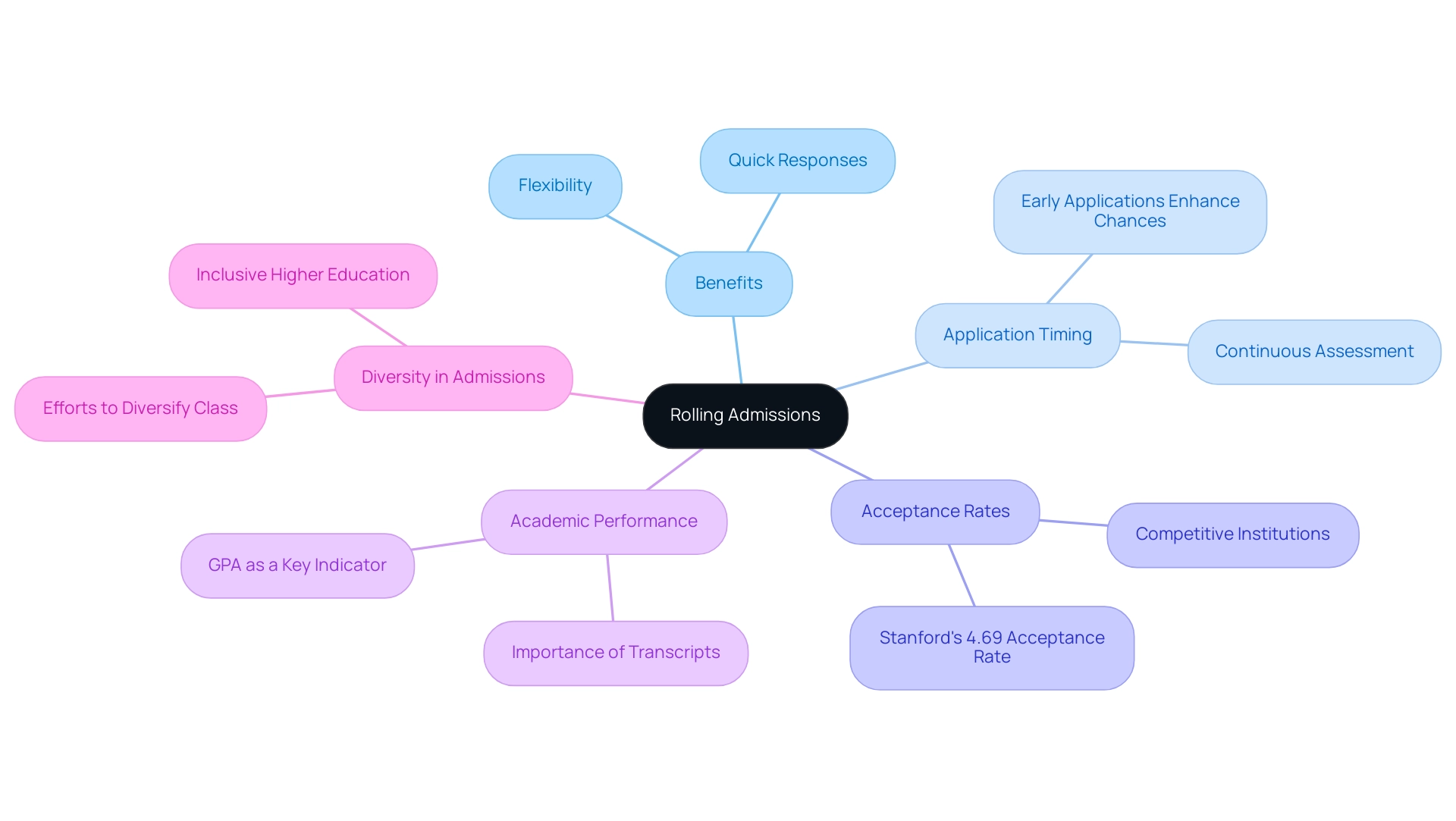
Comparing Rolling Admissions with Other College Admissions Strategies
In assessing different college entry strategies, it is vital to grasp the differences between flexible entry, early action, and regular decision options. Early action allows individuals to submit requests ahead of schedule and receive decisions sooner, offering a non-binding choice that enables accepted individuals to take their time before committing until the common reply date. Conversely, regular decision typically entails a later submission deadline, with decisions communicated at a predetermined time.
The characteristic of ongoing enrollment resides in its constant assessment procedure, which provides the possibility for accelerated acceptance but requires an anticipatory approach from learners. For example, applications for CSU are accepted continuously after February 1, demonstrating how this process functions in practice. Each strategy presents unique advantages and challenges.
For instance, rolling types of enrollment can assist individuals who intend to apply to multiple institutions without the limitations of set deadlines, while early action may be more attractive to those eager to obtain acceptance at their preferred choice early in the process. As one parent of a 2024 graduate remarked, ‘I wonder what percent of individuals boost their resume sufficiently to move them from denied in EA to accepted in RA.’ I doubt it’s a significant number.
This perspective adds a personal touch to the discussion on the effectiveness of these strategies. Furthermore, individuals must be aware of both general entry deadlines and specific timelines for their chosen majors, as emphasized in the case study regarding special deadlines for particular programs. Grasping these nuances can greatly affect an individual’s approach, ultimately shaping their educational path.
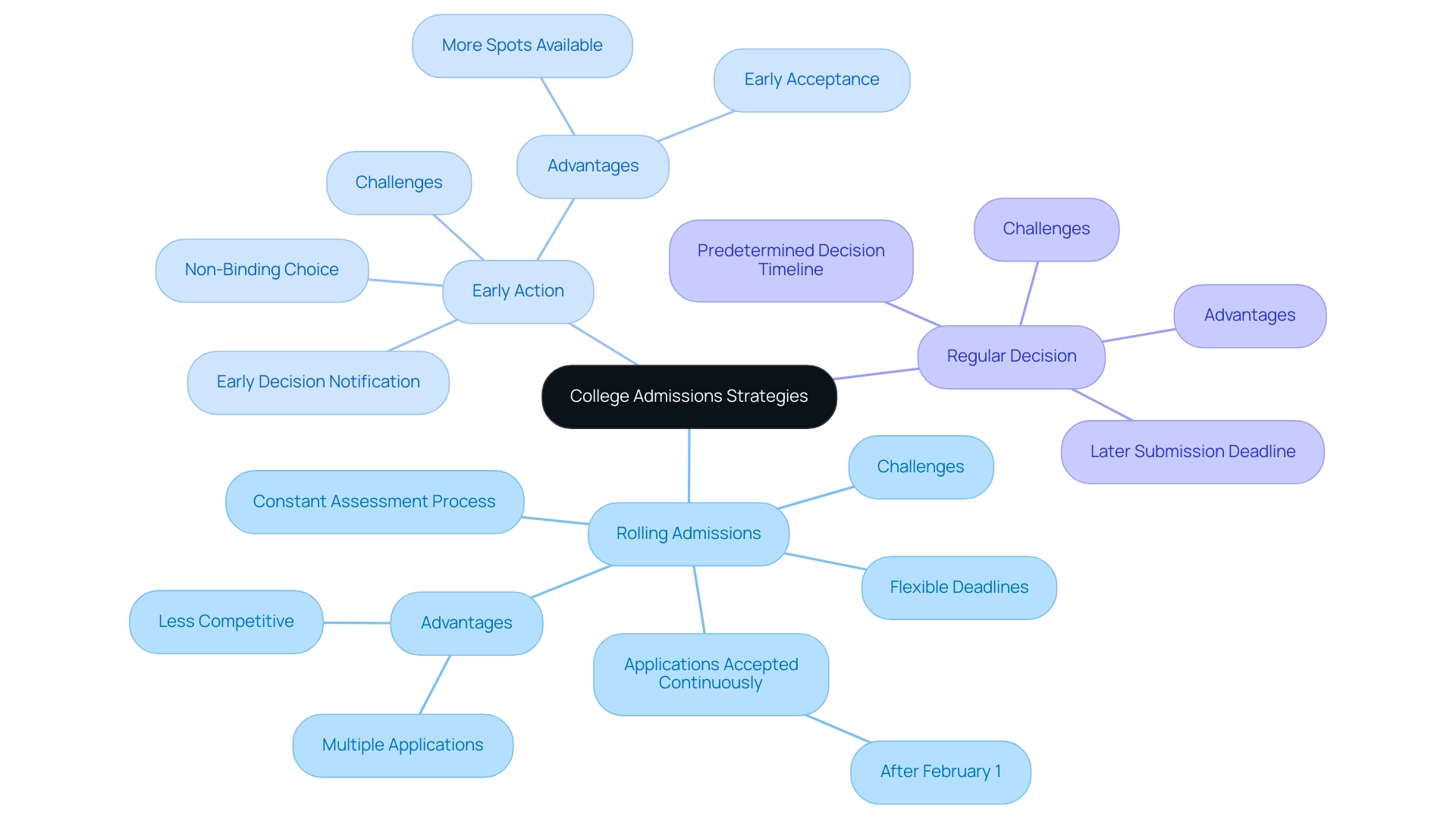
Key Benefits of Rolling Admissions
The rolling types of admissions offer a variety of considerable benefits for individuals exploring the college enrollment environment. One of the primary advantages is the inherent adaptability of the timeline, enabling individuals to submit their requests when they feel most ready. This flexibility alleviates pressure associated with fixed deadlines, contributing to a less stressful application experience for rolling types.
Additionally, learners gain from getting acceptance notifications more quickly, which aids in better planning for their next actions—whether that includes getting ready for college or considering different options.
Significantly, continuous enrollment can improve acceptance rates for rolling types of applications, especially for those who submit applications early in the process, as fewer positions are usually occupied at that time. For example, individuals targeting Grantham University must achieve a SAT score of 880 or an ACT score of 18, which can be more feasible with the adaptability of continuous enrollment. This proactive approach not only increases the likelihood of acceptance but also empowers individuals with the ability to apply to multiple institutions simultaneously.
The lack of strict deadlines encourages a feeling of mastery over the college selection procedure. Sophia Minhas highlights this aspect, mentioning,
Furthermore, using flexible enrollment can assist you with early financial aid preparation, rendering the college planning experience somewhat less daunting (and aiding you in saving money in the future, as well!)
This is especially pertinent given that the University of New Hampshire has an undergraduate tuition of $38,882 and 96% of learners receive financial assistance averaging $13,573. Such insights demonstrate the wider advantages of flexible enrollment processes, especially for rolling types of individuals who might overlook conventional deadlines, as illustrated in case studies showcasing the benefits for those making late choices. The case study titled ‘Late Decisions and Rolling Admissions’ illustrates that these individuals often find additional spots remain available in the spring, granting them the opportunity to enroll in institutions that might have otherwise been out of reach.
Overall, flexible enrollment options not only offer adaptability but also strategically equip individuals for success in their college journey.
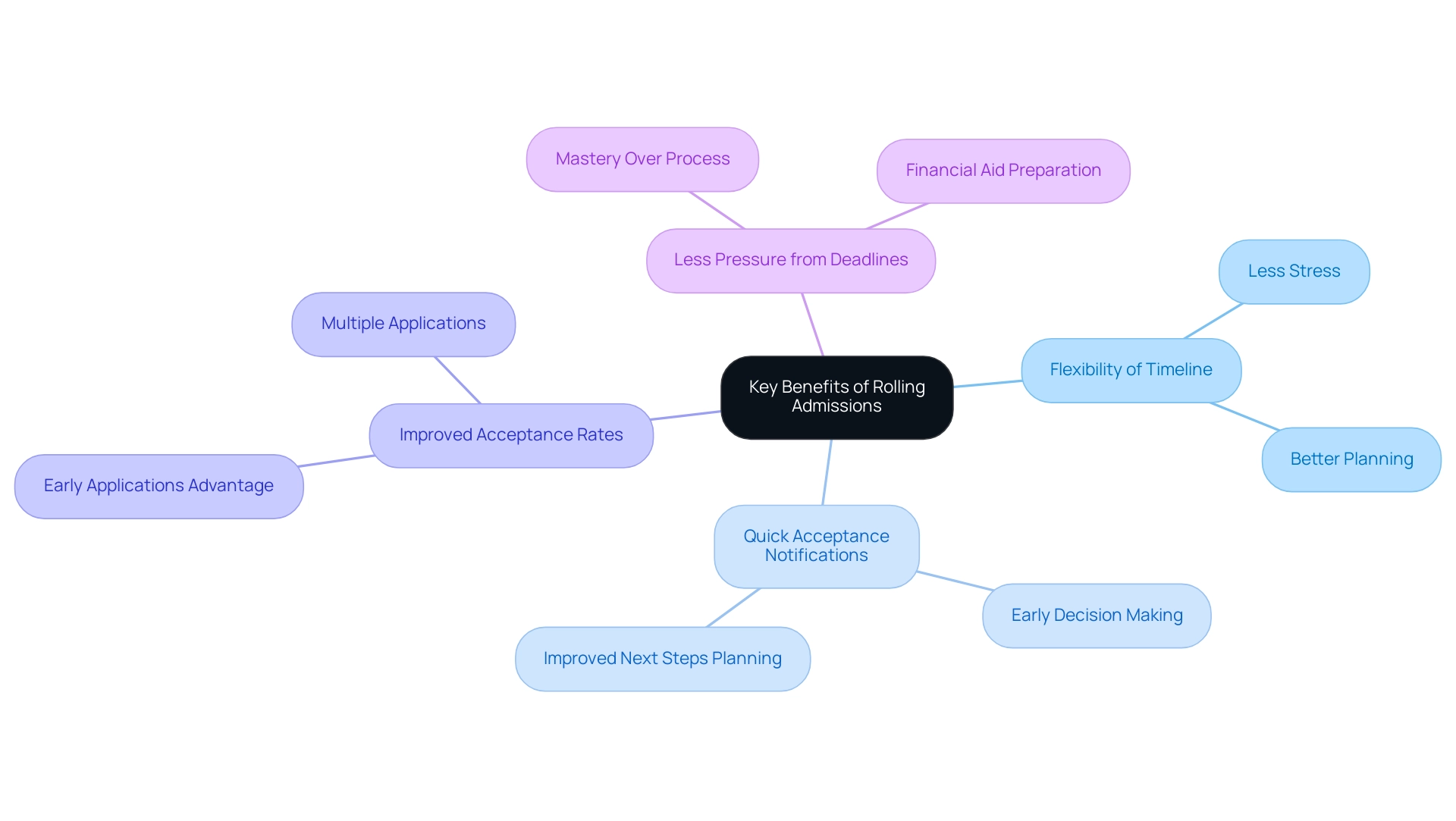
Challenges of Rolling Admissions
While continuous enrollment provides flexibility and opportunities for applicants, it also presents several challenges that must be navigated carefully. One of the primary concerns is the heightened competition inherent in this system; as spots are filled on a continuous basis, prospective students often find themselves vying for limited openings. This competitive nature is particularly pronounced in 2024, as more institutions adopt rolling types of admissions, further intensifying the race for acceptance.
In May 2009, there were 2 posts that highlighted this competitive landscape, underscoring the challenges applicants face. Experts emphasize that applicants must be prepared to submit polished and comprehensive documents at any moment, which can create significant pressure. The uncertainty surrounding admission choices adds another layer of complexity; while some individuals welcome the prospect of receiving quicker feedback, others may find the prolonged waiting period stressful, especially when juggling multiple submissions.
To effectively manage these challenges, it is crucial for students to stay organized and proactive, ensuring that they meet all deadlines and maintain a strong application profile. As highlighted by Wayne State University, situated in Midtown Detroit, Michigan, the competitive aspect of rolling types of flexible enrollment requires a strategic method. The University of Pittsburgh serves as a pertinent case study, having been founded in 1787 and recognized for its significant research impact.
This institution demonstrates how continuous enrollment can enable year-round participation, yet also require a dedication to achieving particular GPA and test score standards in the face of tough competition. As expressed by industry specialists, successfully managing the complexities of continuous enrollment necessitates a strategic method that balances preparation, organization, and resilience.
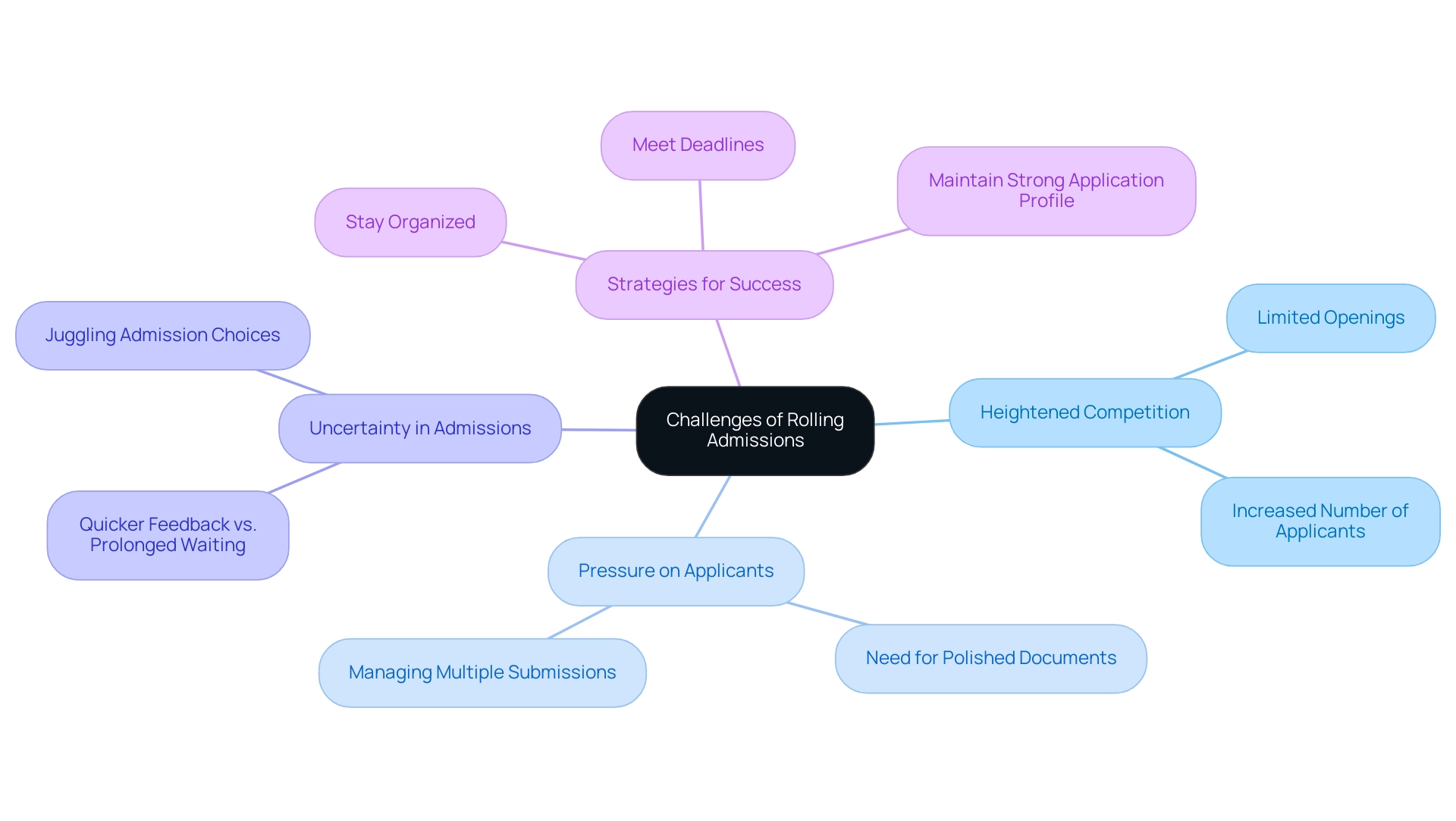
Tips for Navigating Rolling Admissions Successfully
Successfully navigating rolling types of admissions requires a strategic approach, beginning with thorough research on colleges that offer this admissions option. Comprehending their unique submission timelines and specific requirements is essential for maximizing opportunities. Preparing materials—such as essays, letters of recommendation, and transcripts—well ahead of deadlines will facilitate timely submissions.
Submitting materials early is especially beneficial, as it can greatly enhance acceptance odds; in fact, students who collaborate with committed advisors can attain up to 11 times more success in securing spots at prestigious universities. Keeping consistent contact by verifying status updates and following up with enrollment offices shows authentic interest and proactive involvement. Additionally, candidates should be ready to make prompt decisions upon acceptance, as spaces can fill rapidly, and hesitation may result in missed opportunities.
For example, The University of Alabama has a priority submission deadline of January 15, after which enrollments are offered on a space-available basis. Likewise, Indiana University Bloomington, positioned #73 nationally with an 82% acceptance rate, provides several submission deadlines, including a November 1 Early Action deadline and a November 15 priority deadline for ongoing enrollments. This illustrates the benefits of adhering to priority deadlines and applying early.
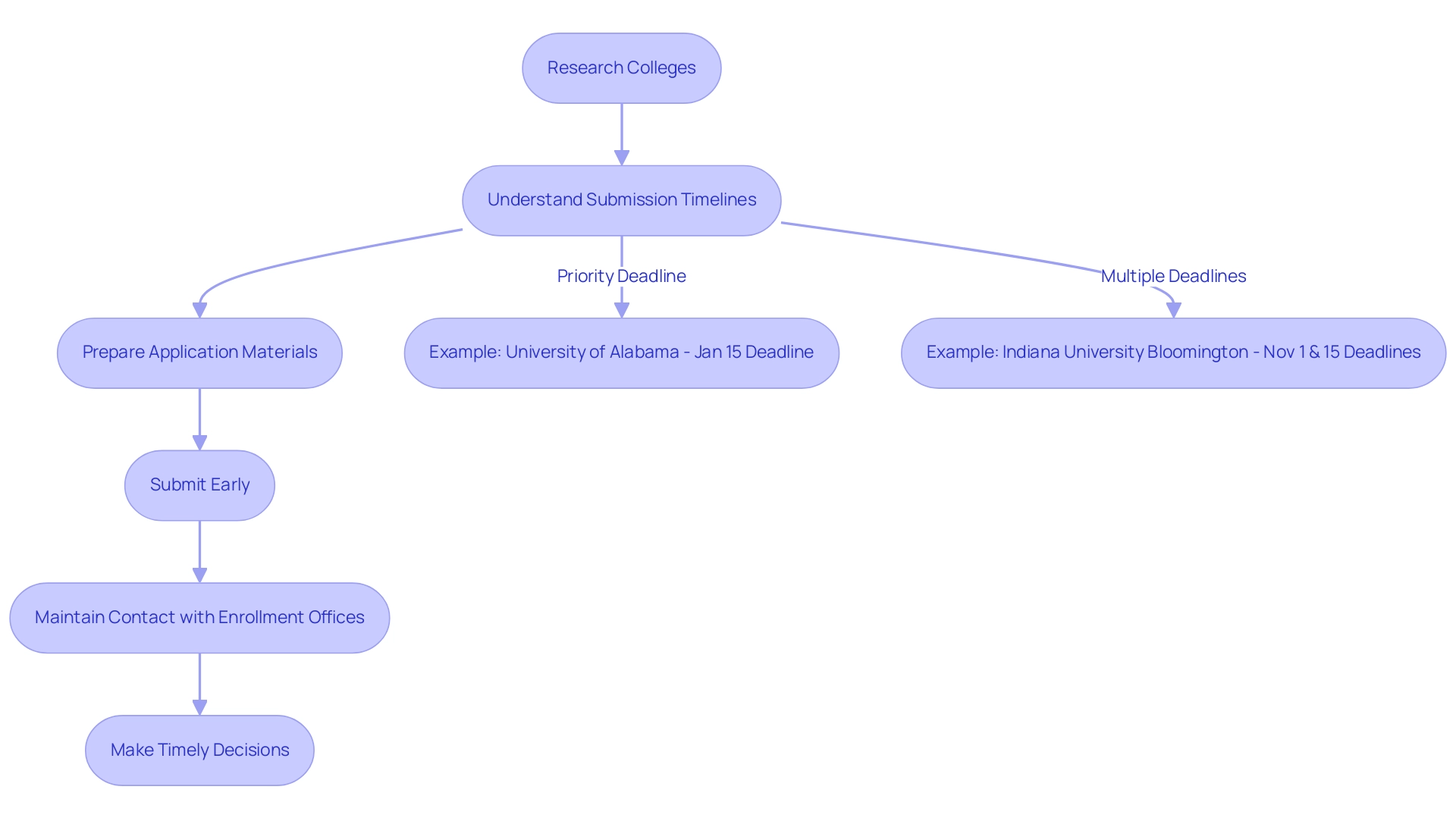
Conclusion: Making Informed Choices in College Admissions
Rolling enrollment provides a unique benefit for individuals navigating the college application landscape, giving them the freedom to apply at different times during the application cycle. By understanding the complexities of rolling types and comparing this method with other strategies, individuals can greatly enhance their chances for acceptance. It’s crucial to acknowledge that Early Decision deadlines usually happen roughly six weeks sooner than regular deadlines, and accepted candidates must retract other submissions, emphasizing the necessity for a well-informed strategy.
As noted by Benjamin Caldarelli, a partner at Princeton College Consulting:
It is important to understand the differences between ED, EA, and single choice EA and to discuss your strategy with an advisor.
This statement highlights the necessity of proactive planning and consultation in optimizing application strategies. Moreover, data shows that individuals with higher SAT scores are increasingly sending more score reports, with those achieving above 1400 submitting a median of eight reports, which reflects a trend toward strategic positioning in enrollment.
Significantly, 49 percent of individuals at selective private institutions originate from out-of-state or out-of-region, demonstrating the competitive character of enrollment. Colleges that exhibit high Early Decision acceptance rates serve as valuable targets for individuals aiming to enhance their chances of admission; statistics show which colleges admit the highest number of applicants through their Early Decision programs. Ultimately, a strategic and informed approach, characterized by organization and timely action, empowers students to make optimal choices for their educational futures.
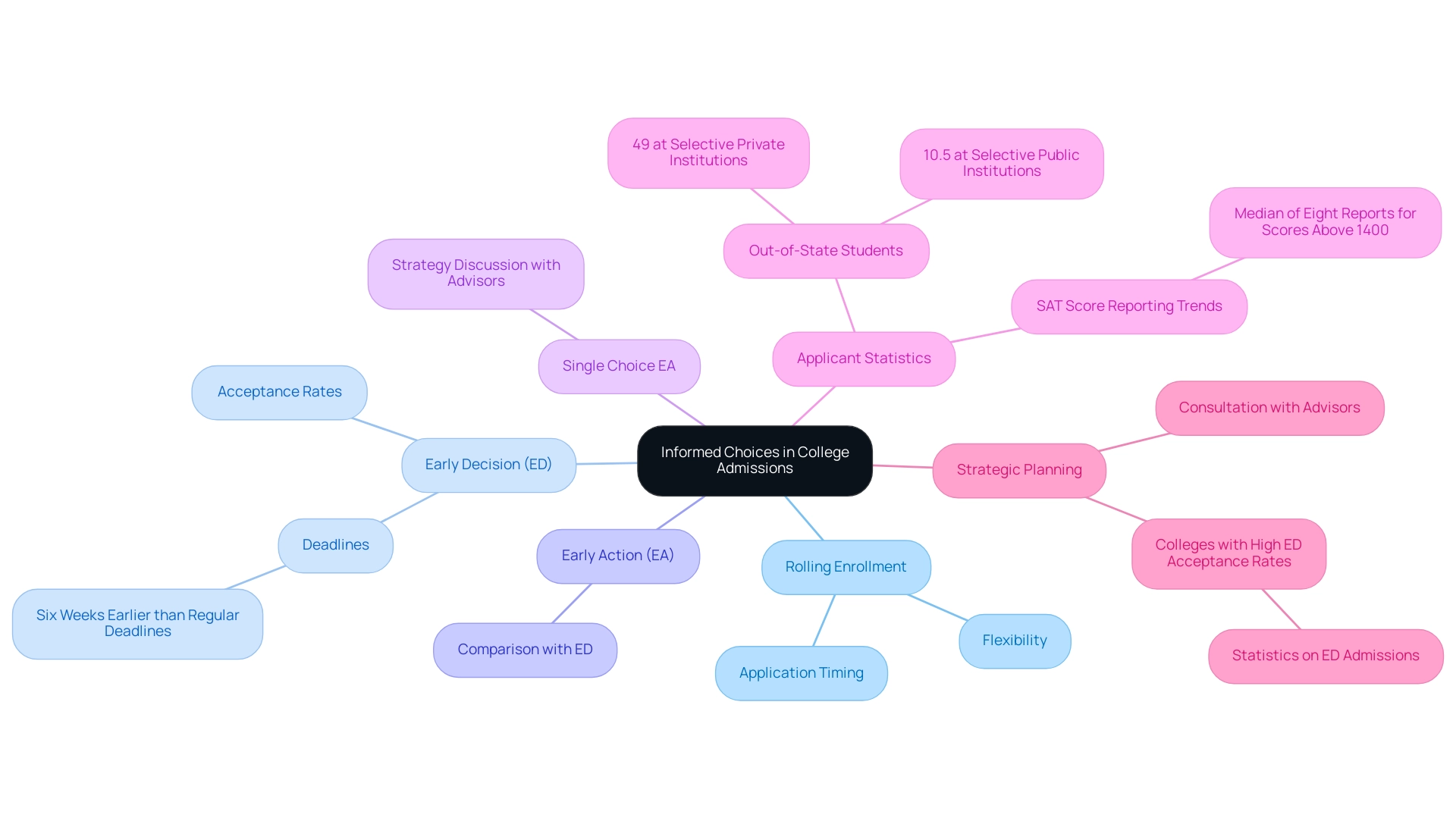
Conclusion
Rolling admissions represent a pivotal opportunity for students seeking to enhance their college admissions prospects. By understanding the nuances of this approach and how it compares to early action and regular decision strategies, applicants can position themselves advantageously in a competitive landscape. The flexibility of rolling admissions allows students to submit applications when they feel most prepared, while also benefiting from the potential for quicker acceptance decisions.
However, this approach is not without its challenges. The continuous evaluation process creates a highly competitive environment, requiring applicants to remain organized and proactive. As institutions increasingly adopt rolling admissions, the need for a well-prepared application becomes paramount. Students must be ready to act swiftly upon receiving an acceptance, as spaces can fill rapidly.
To navigate rolling admissions successfully, thorough research and strategic planning are essential. By preparing application materials in advance and maintaining open communication with admissions offices, students can demonstrate their commitment and maximize their chances of acceptance. Ultimately, a strategic and informed approach empowers students to make optimal choices in their college journey, ensuring they are well-equipped to seize the opportunities that rolling admissions present.




